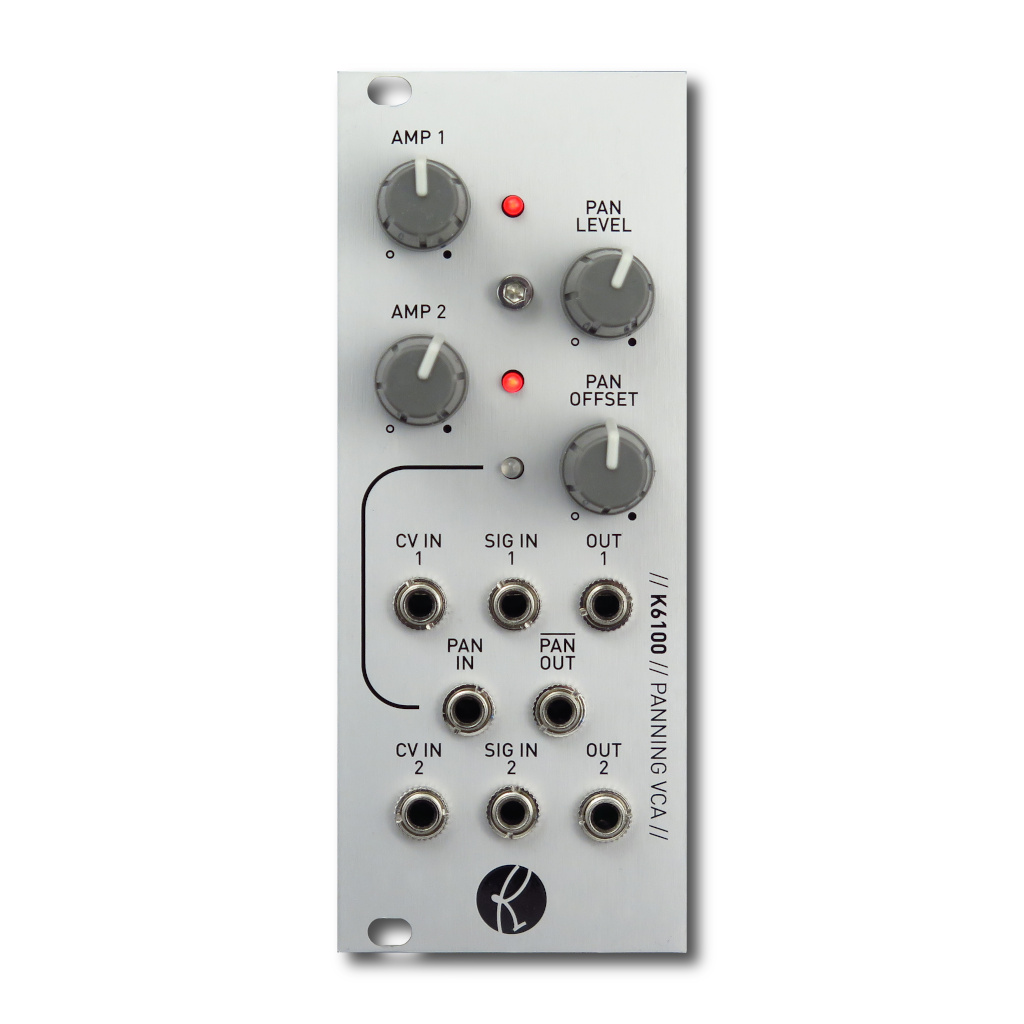K6100 Panning VCA
User Manual

Download a PDF version of the manual here: K6100-panning_vca-manual.pdf
Note that PDF manuals are automatically generated from webpages. Links and embedded media will not be accessible. For the full experience visit our website: www.kilpatrickaudio.com
Introduction
The K6100 Panning VCA from Kilpatrick Audio is a compact and great sounding VCA. It will become an essential part of any system. Use it as two independent VCAs, or together as a stereo VCA or panner.Setup
The K6100 Panning VCA requires only +12V and -12V. Make sure you use a good power supply that is not overloaded. The voltages should measure as close to +12V and -12V as possible.
To get something happening right away, just connect an oscillator signal to the SIG IN 1 jack, and connect the OUT 1 jack to your mixer or output interface. Set the PAN OFFSET control in the centre position and adjust the AMP 1 control. The volume of the signal should go up and down.
Now try feeding an LFO into the CV 1 jack and get some tremolo going on!
Jacks and Controls
The K6100 is a dual channel unit. Each channel can be used independently. The CV 1 and SIG 1 input jacks are normalled to the second channel. If a plug is not inserted in either the CV 2 or SIG 2 jack, the CV 1 or SIG 1 signals respectively will be automatically patched to the second channel.
The function of each of the jacks is as follows:
- CV 1 - Amplitude (VCA) control input for channel 1
- SIG 1 - Audio signal input for channel 1
- OUT 1 - Audio signal output for channel 1
- CV 2 - Amplitude (VCA) control input for channel 2 - with no plug inserted this receives the signal from CV 1
- SIG 2 - Audio signal input for channel 2 - with no plug inserted this receives the signal from SIG 2
- OUT 2 - Audio signal output for channel 2
- PAN IN - Panning control input - affects both channels
- /PAN OUT - Inverted version of the PAN IN signal for convenience use
Controls
Each channel can work independently. When using independently make sure the PAN OFFSET control is set in the centre position. The panning circuits affect both channels.
The function of each control is as follows:
- AMP 1 - Controls the amplitude of VCA 1 - use this as a manual volume control or to tailor the response to match your CV input signal - an LED next to this control shows the VCA 1 status
- AMP 2 - Same as AMP 1 but controls VCA 2 - an LED next to this control shows the VCA 2 status
- PAN LEVEL - Affects the depth of panning from the PAN IN jack
- PAN OFFSET - Affects the pan balance between the two channels - use this as a manual pan control or to adjust the panning response between the two channels - an LED beside this control shows the pan status: red (left), green (right), and off (centre)
Audio and Control Voltages
Kilpatrick Audio strives to make products with the most convenient and universal voltage standards possible. We believe in the approach that everything should be able to patch into everything and therefore all our modules are based around the most universal -5V to +5V range. Pulses and gates are 0V off / +5V on. Pitch voltages range from -5V to +5V and use the standardized 1 volt per octave scaling. Audio, LFO and envelope voltages also range from -5V to +5V. This gives the absolute best compatibility between different module types. Our non-Eurorack products also follow this same system.
Whenever you see an offset control on one of our modules that is mixed with a CV input, there is an easy way to picture how it works. Simply imagine the offset control setting the value of the particular function with no input signal. (or a 0V input signal) Putting a CV signal into the corresponding input jack will simply add or subtract from this offset setting. Some inputs have attenuator controls (we call them LEVEL) that allow you to scale the input signal. This simply scales down the input signal before it can affect the internal circuitry.
Need Help?
Feel free to contact us for more information, to report errors or unclear sections, or to request specific information be added to this manual.

